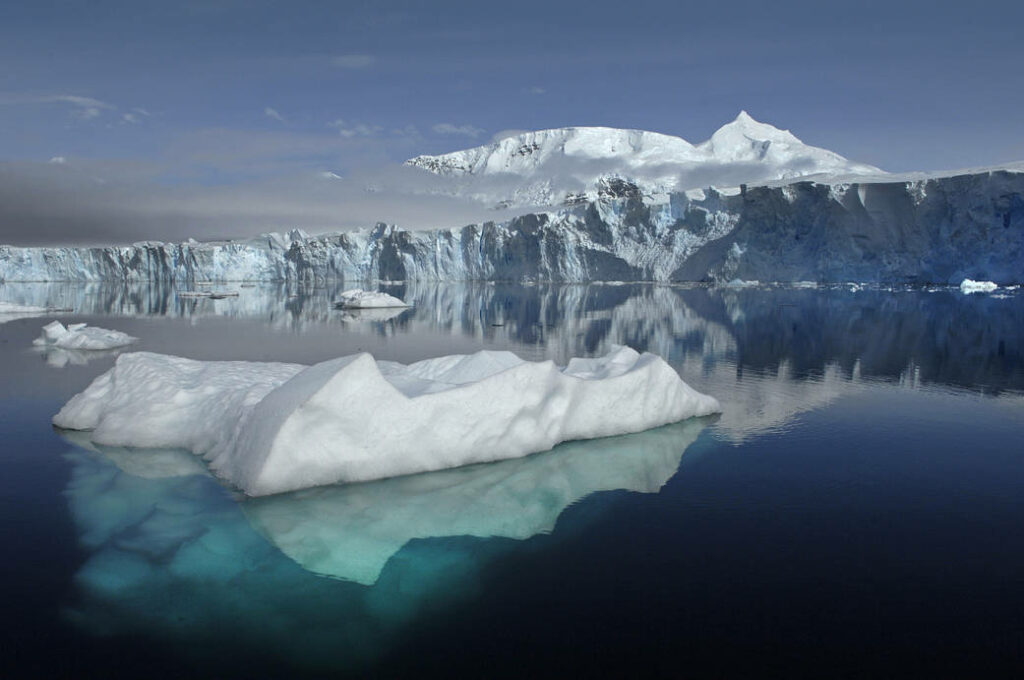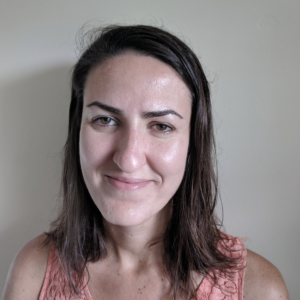
View of Sheldon Glacier with Mount Barre in the background, seen from Ryder Bay near Rothera Research Station, Adelaide Island, offshore of the Western Antarctic Peninsula – Image credit: British Antarctic Survey
story by Helen Hill for MITgcm
The Southern Ocean plays a critical role in the global carbon cycle by acting as a major sink for CO2. In particular, coastal regions around Antarctica can be understood to play an outsize role, with high biological productivity there having the potential to act as a particularly strong sink for anthropogenic carbon. However, large-scale air-sea CO2 flux estimates for Antarctic coastal regions are confounded by limited data coverage, calling for modeling studies to help improve researchers’ understanding of the air-sea flux and biological carbon cycling that can happen there.

Cristina Schultz began using MITgcm during her time as a graduate student working at WHOI. Schultz is currently a postdoc at Princeton/NOAA GFDL.
To that end, Cristina Schultz, while a postdoc in Scott Doney’s Computational Biogeochemical Lab at the University of Virginia’s Department of Environmental Science used an ocean circulation, sea-ice, and biogeochemistry model of the West Antarctic Peninsula (WAP) to study how the cycle of sea-ice affects cycles in phytoplankton and surface dissolved inorganic carbon (DIC) there. A preprint of the paper to come out of her study, co-authored with Doney, Judith Hauck (Alfred Wegener Institute), Maria Kavanaugh (Oregon State University), and Oscar Schofield (Rutgers), was recently accepted for publication in the Journal of Geophysical Research – Biogeosciences.
In their study, Schultz et al overlaid the biogeochemical model REcoM2, on the regional (hydrostatic) version of MITgcm had previously been used to explore how the sea ice cycle and Langmuir Circulation influence the upper ocean mixed layer depth and freshwater distribution in the WAP (Schultz et al, 2020). Their implementation has a horizontal resolution of 0.2 degrees in longitude, varying between ~0.05 and ~0.12 degrees in latitude and 50 vertical levels with 10m resolution in the top 120 m. It is driven by atmospheric forcing derived from the ERA-Interim reanalysis with monthly climatological freshwater runoff estimates from Van Wessem et al (2016) distributed in a 100 km ribbon along the coast.
An animation comparing vertically integrated net primary production and sea ice concentration (black lines) during a season of early sea ice retreat (left) and late sea ice retreat (right) – video credit: Cristina Schultz
Comparing their results with satellite sea-ice and ocean color data, as well as shipboard surveys from the Palmer Long Term Ecological Research program of which Doney is a long-time PI, the team noted that, despite lower chlorophyll in January, the longer growth season in years of early sea-ice retreat leads to higher seasonally integrated Net Primary Production (NPP). Their results also suggested the important role sea-ice plays in DIC drawdown by controlling the duration of the phytoplankton bloom, air-sea CO2 fluxes, and dilution by meltwater. “The timing of the phytoplankton bloom is hard to capture with ship-based observations and satellites due to sea ice and cloud coverage. Our results suggest that early sea ice retreat leads to an earlier bloom, with overall higher productivity during the summer season but lower chlorophyll concentrations in January,” says Schultz. “In years of late sea ice retreat, the bloom is closer to the peak in January, but the associated larger drawdown in DIC also reflects smaller air-sea CO2 fluxes and increased sea ice melt. If the trends towards longer ice-free seasons and increased glacial melt persists, it is likely that the WAP will be a larger sink of atmospheric carbon with increased Net Community Production.”
To find out more about this work contact Cristina.
This Month’s Featured Publication
- Cristina Schultz, Scott C. Doney, Judith Hauck, Maria Kavanaugh, Oscar Schofield (2020), Modeling phytoplankton blooms and inorganic carbon responses to sea-ice variability in the West Antarctic Peninsula (WAP), Journal of Geophysical Research – Biogeosciences, doi: 10.1029/2020JG006227
Related Publication
- C. Schultz, S.C. Doney, W.G. Zhang, H. Regan, P. Holland, M.P. Meredith, S. Stammerjohn (2020), Modeling of the Influence of Sea Ice Cycle and Langmuir Circulation on the Upper Ocean Mixed Layer Depth and Freshwater Distribution at the West Antarctic Peninsula, Journal of Geophysical Research – Oceans, doi: 10.1029/2020JC016109
Other New Publications this Month
Lu An, Eric Rignot, Michael Wood, Josh K. Willis, Jeremie Mouginot, and Shfaqat A. Khan (2021), Ocean melting of the Zachariae Isstrøm and Nioghalvfjerdsfjorden glaciers, northeast Greenland, PNAS, doi: 10.1073/pnas.2015483118
Alessandro Anav, Adriana Carillo, Massimiliano Palma, Maria Vittoria Struglia, Ufuk Utku Turuncoglu, and Gianmaria Sannino (2021), The ENEA-REG system (v1.0), a multi-component regional earth system model. Sensitivity to different atmospheric component over Med-CORDEX region, Geoscientific Model Developments, doi: 10.5194/gmd-2020-248
Eli Biton (2020), Possible implications of sea-level changes for species migration through the Suez Canal, Nature Scientific Reports, doi: 10.1038/s41598-020-78313-2
M. Bolado‐Penagos et al (2021), Revising the effects of local and remote atmospheric forcing on the Atlantic Jet and Western Alboran Gyre dynamics, JGR Oceans, doi: 10.1029/2020JC016173
de Fiegueiredo Melo Villas Bôas, Ana Beatriz (2020), Wind, wave, and current interactions, UC San Diego Doctoral Dissertation [pdf]
Lei Han (2021), The sloshing and diapycnal meridional overturning circulations in the Indian Ocean, Journal of Physical Oceanography, doi: 10.1175/JPO-D-20-0211.1
Alexander Forryan, Alberto C. Naveira Garabato, Clément Vic, A. J. George Nurser & Alexander R. Hearn (2021), Galápagos upwelling driven by localized wind–front interactions, Nature Scientific Reports, doi: 10.1038/s41598-020-80609-2
Q. Jamet, B. Deremble, N. Wienders, T. Uchida, WK Dewar (2021), On Wind-driven Energetics of Subtropical Gyres, Journal of Advances in Modeling Earth Systems, doi: 10.1029/2020MS002329
Bui Hong Long, Phan Minh Thu, Nguyen Nhu Trung (2021), Initial understanding and assessment of role of oceanographic features for ferromanganese crusts and nodules in the East Vietnam Sea, Vietnam Journal of Marine Science and Technology, doi: 10.15625/1859-3097/15775
Chao Min, Qinghua Yang, Longjiang Mu, Frank Kauker, and Robert Ricker (2021), Ensemble-based estimation of sea-ice volume variations in the Baffin Bay, The Cryosphere, doi: 10.5194/tc-15-169-2021
Alok Kumar Mishra, Suneet Dwivedi & Fabio Di Sante (2020), Performance of the RegCM-MITgcm Coupled Regional Model in Simulating the Indian Summer Monsoon Rainfall, Pure and Applied Geophysics, doi: 10.1007/s00024-020-02648-0
Casey R. Patrizio and David W.J. Thompson (2021), Quantifying the Role of Ocean Dynamics in Ocean Mixed-Layer Temperature Variability, Journal of Climate, doi: 10.1175/JCLI-D-20-0476.1
Qian Shi, Qinghua Yang, Longjiang Mu, Jinfei Wang, François Massonnet, and Matthew R. Mazloff (2021), Evaluation of sea-ice thickness from four reanalyses in the Antarctic Weddell Sea, The Cryosphere, doi: 10.5194/tc-15-31-2021
Xianyu Tan and Adam P. Showman (2021), Atmospheric circulation of brown dwarfs and directly imaged exoplanets driven by cloud radiative feedback: global and equatorial dynamics, arXiv: 2101.04417 [astro-ph.EP]
Carl P. Spingys, Alberto C. Naveira Garabato, Sonya Legg, Kurt L. Polzin, E. Povl Abrahamsen, Christian E. Buckingham, Alexander Forryan, and Eleanor E. Frajka-Williams (2021), Mixing and Transformation in a Deep Western Boundary Current: A Case Study, Journal of Physical Oceanography, doi: 10.1175/JPO-D-20-0132.1
Michael Wood et al. (2021), Ocean forcing drives glacier retreat in Greenland, Science Advances, doi: 10.1126/sciadv.aba7282
Xiu Y, Min C, Xie J, Mu L, Han B, Yang Q (2021), Evaluation of sea-ice thickness reanalysis data from the coupled ocean-sea-ice data assimilation system TOPAZ4, Journal of Glaciology, doi; 10.1017/jog.2020.110
Xiaoting Yang, Eli Tziperman, and Kevin Speer (2021), Deep Eastern Boundary Currents: idealized models and dynamics, Journal of Physical Oceanography, doi: 10.1175/JPO-D-20-0227.1
Yaoxuan Zeng and Malte F. Jansen (2021), Ocean Circulation on Enceladus With a High Versus Low Salinity Ocean, arXiv:2101.10530 [astro-ph.EP]
Do you have news about research using MITgcm? We are looking for contributions to these pages. If you have an interesting MITgcm project (ocean, atmosphere, sea-ice, physics, biology or otherwise) that you want to tell people about, get in touch. To make a post, contact Helen
